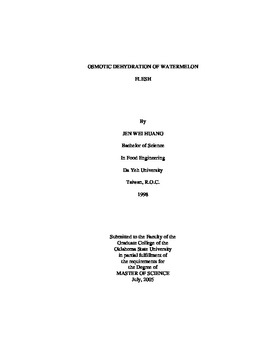| dc.description.abstract | Late harvested or second-class watermelons are often wasted or left in the field. A food preservation process yielding an acceptable product is needed to capitalize on this otherwise wasted commodity. Watermelons were dried to produce a shelf-stable watermelon product made from osmotic dehydration. Peeled watermelon flesh (3x3x3 cm cubes) was pre-treated with additives (sugar, CaCl2, and aluminum powder) followed by either forced-air or vacuum drying. Three studies were conducted to evaluate the effects of additives and drying systems. In the first study, raw watermelon cubes were soaked in either 50� or 10� Brix sugar solutions for 2hrs followed by forced-air drying at 60� C. In the second study, CaCl2 and aluminum powder additives were applied prior to the 50� Brix osmotic pre-treatment to improve the quality of the watermelon samples. In the third study, watermelon samples were pre-treated with both additives and the 50� Brix sugar solution prior to either forced-air or vacuum drying. Samples were taken at drying times of 0, 2, 7, 13, 19, and 31 hours. Dried watermelons were evaluated by water activity, moisture content, color, and texture. The Hunter Lab color values were determined using a hand-held colorimeter, and the Warner-Bratzler shearing test was conducted using a texture analyzer (TA.XT2). Findings and Conclusions: Soaking watermelon samples in the 50� Brix sugar solution resulted in a faster drying rate, less change in color, and a softer texture than the 10� Brix solution. In the second comparison, the use of pre-treatment additives did not affect the rate of water loss during drying. However, dried watermelons with CaCl2 and alum additives did result in less color change and softer texture. In the third comparison, the forced-air drying resulted in a faster drying rate during the earlier drying stages (< 7 hrs) and the vacuum drying resulted in a faster drying rate during the later drying stages. Force-air drying also resulted in a softer texture in the dried product. In conclusion, osmotic dehydration proved to be a useful method for producing a dried watermelon product. | |
